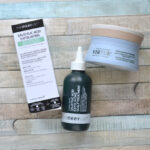
How to Prevent The Final Takeaway
Pimples are a common occurrence for many of us—and in most cases, we’re used to dealing with them on our face, neck, chest, or back. However, pimples can appear in other places, like behind the ears. If you’ve ever dealt with pesky pustules behind your ear, you’ve likely wondered about the causes and treatment options. To help you put your questions to rest, we tapped two board-certified dermatologists for answers. Ahead, learn everything you need to know about pimples behind the ears.
Causes of Pimples Behind the Ears?
Clogged Pores
Clogged pores can lead to behind-the-ear pimples. They are caused by an overproduction of oil or decreased shedding of the skin, typically presenting in the form of whiteheads or blackheads. «[The distinguishing factor] is the presence of a ‘plug’ within the pore,» Dr. Chilukuri notes. «To treat, consider PanOxyl Acne Creamy Wash ($9) as a wash and then a retinoid. In the past, one would have to visit a physician’s office to obtain a prescription for retinoids such as Differin or Retin-A. Now [those with acne] can order PanOxyl Adapalene 0.1% Leave-On Gel ($11) online for a fraction of the original cost.»
Acne
Acne is what Dr. Murphy-Rose calls an umbrella category. You may see pustular acne in the form of one to three-millimeter red bumps behind the ears, typically tender and recognizable by the presence of inflammatory lesions.
«With this type of acne, the bacterial growth has led to greater inflammation leading to the red papules or pustules,» says Dr. Chilukuri. «One can use salicylic acid to decrease inflammation when necessary. For painful bumps, consider using the PanOxyl PM Overnight Spot Patches ($8). I also recommend using a retinoid to improve cell turnover and skin shedding so it is harder to block the pore.»
Cysts
Cystic acne can also occur behind the ears; typically, the visible lumps are deeper and more painful. «Cysts are caused by a collection of oil, bacteria, and pus under the skin’s surface,» Dr. Chilukuri says. «They are very likely to cause permanent scarring and may be a result of genetics and hormones. It is very important to see a board-certified dermatologist to evaluate if you are a candidate for an oral medication to prevent permanent scarring.»
Ingrown Hairs
Ingrown hairs typically appear as small red or flesh-colored bumps on or behind the ear and are recognizable by the trapped hair within the bump. «Ingrown hairs occur when hair follicles curl and get trapped under the skin surface,» Dr. Chilukuri says. «I don’t often see ingrown hairs behind the ears because there is no significant hair growth there, but it can occur along the base of the neck and hairline.»
Pore-Clogging Hair Products
It should come as little surprise that pore-clogging products can result in acne, and often, it's hair products that cause pimples, specifically behind the ears where your hair is making contact on the daily. "The occlusive nature of oils, conditioners, and some dry shampoos can clog pores, causing blackheads and whiteheads around the ears and hairline," Dr. Murphy-Rose says.
"Opt for noncomedogenic hair products, both in the shower and out," Dr. Chilukuri suggests. "Make sure to thoroughly cleanse the affected area to remove any residue clogging pores. If you think your styling products are the cause of breakouts, use a toner pad or liquid toner with salicylic acid to wipe away any residue and deposit acne-fighting ingredients."
How to Treat Pimples Behind Ears
Try Topical Treatments
The first line of treatment is typically topical, both experts note. «Salicylic acid is a great choice for acne prevention,» Dr. Murphy-Rose says. «This molecular size of this acid enables it to travel into pores to deeply clean and dissolve sebum, and its exfoliating action treats and prevents further clogging of pores. A prescription-strength retinoid or retinol are great choices as well. Using Skincare Junkie’s Pore Therapy Daily Toner Pads ($38) can help prevent blackheads and treat existing ones.»
Consider Oral Prescriptions
If topical treatments are not getting the job done, oral medications may be the next line of defense for acne anywhere, including behind the ear. «Oral antibiotics, isotretinoin (i.e., Accutane), and spironolactone are most commonly prescribed depending on the patient and type of acne,» Dr. Murphy-Rose says.
Try Home Remedies
Home remedies may also work for behind-the-ear pimples, like a warm compress. «One of the most common home remedies for acne is tea tree oil,» Dr. Murphy-Rose adds. «While other acne treatments may be more effective, the anti-microbial and anti-inflammatory effects of this natural topical treatment can certainly help the fight against acne.»
But it's worth noting that our experts don't recommend creating DIY topical cocktails to treat your pustules. "I don't recommend any homemade mixtures be applied to the skin as they often lead to skin breakdown that will worsen acne," adds Dr. Chilukuri.
How to Prevent Behind the Ear Pimples
Use a Gentle Cleanser
According to our experts, cleansing is a simple but crucial step in preventing acne behind the ears. «Use a gentle, non-irritating cleanser to keep skin clear of acne-promoting bacteria without stripping skin and breaking down the protective skin barrier,» Dr. Murphy-Rose notes.
Avoiding Pore-Clogging Products
As mentioned, clogged pores can lead to whiteheads and blackheads, so avoiding comedogenic products is best. "Choose hair products carefully, opting for those labeled non-comedogenic," Dr. Chilukuri says. "Make sure to rinse well after conditioning [your hair] and wipe off any excess styling product that may get on the skin to prevent further breakouts."
Keep Your Hair Away from Your Ears
Dr. Murphy-Rose notes that wearing your hair up, especially during a workout, can help prevent acne behind the ears. "Keeping hair away from the ears reduces the transfer of oils or hair products from the hair to the skin that may be causing clogged pores or irritation," Dr. Chilukuri says.
The Final Takeaway
While behind the ear is not the most common spot for pimples, they can appear there. Pore-clogging hair care products and acne are just some potential culprits behind a behind-the-ear pustule. But thankfully, there are plenty of ways to treat them if they appear. Our experts recommend using topical treatments (products with salicylic acid and retinoids are great), applying tea tree oil, or using a warm compress to soothe the area. Of course, if the issue persists or you experience intense symptoms (such as increased redness, swelling, feeling hot to the touch, or discharge), consult a dermatologist for further advice.


